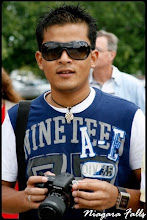

Heavy Light: Recent Photography and Video from Japan provides a subjective and lively glimpse into contemporary Japanese lens-based art. In this book, Christopher Phillips and Noriko Fuku showcase the work of thirteen Japanese artists who participated in the 2008 ICP exhibit of the same name.
Heavy Light unites different generations of photographers working with different techniques, such as cityscapes, kitschy portraiture, video installations and fantastically-staged scenes. In their introduction, Phillips and Fuku explain that their focus is on three themes: urbanism and nature, individual versus collective identity, and the relation of the adult to the child. While these ideas seem relevant to almost every culture, in the pages that follow, the reader learns how the Japanese, specifically, address these conflicts.
Tsuyoshi Ozawa, for example, turns to vegetables. In Ozawa's series "Vegetable Weapon," female models pose with guns constructed from ears of corn, carrots, heads of lettuce, peppers and leeks. Ozawa combined his personal interests in eating, cooking, and women, with an external eye on the world's violence, creating a juxtaposition that provokes laughter along with pensiveness.
Perhaps better-known and slightly more conventional are the portraits by Hiroh Kikai. For decades, Kikai has taken street photographs of people passing by a temple in Asakusa. Kikai provides brief character sketches in his captions, such as, "A maintenance man for industrial dishwashers" or "A man who said he'd just had a drunken quarrel." His raw, honest images convey the personal preoccupations of the quotidian Japanese passers-by.
On the other end of the spectrum is the imaginative and unsettling photography of Miwa Yanagi. Yanagi stages intricate, black-and-white reenactments of traditional fairy tales. In "Gretel," a dazed young girl chews the finger of a veiny, spindly arm. Yanagi explores the antagonistic and ambiguous relationship between the characters.
One of the great things about this compendium is the revealing interview with each photographer. In addition to being able to see an overview of their work, we get to know the personality and ambition of each photographer through this conversational exchange.
Asako Narahashi, for one, explains how she went from creating B-movies to shooting photography with her "eyes deliberately out of focus." She made her ethereal urban landscape series "half awake and half asleep in the water" without once looking into the camera's viewfinder. In her interview with Fuku, she remarks, "I choose a spot, go into the water, snap the shutter, and leave the rest to the camera. It's like I say, 'Okay Mr. Camera, treat me well!' I also pray that the camera doesn't break." Narahashi's humility underlines her creative genius.
The book also includes the work of Makoto Aida, Naoya Hatakeyama, Naoki Kajitani, Midori Komatsubara, Yukio Nakagawa, Tomoko Sawada, Risaku Suzuki, Kenji Yanobe and Masayuki Yoshinaga. Heavy Light makes for a great introduction to the recent and contemporary photography scene in Japan -- from quirky to serious images, all rooted somehow to the history of Japanese art.
— Hilary Moss
Heavy Light:
Recent Photography and Video from Japan
by Christopher Phillips and Noriko Fuku

0 comments:
Post a Comment